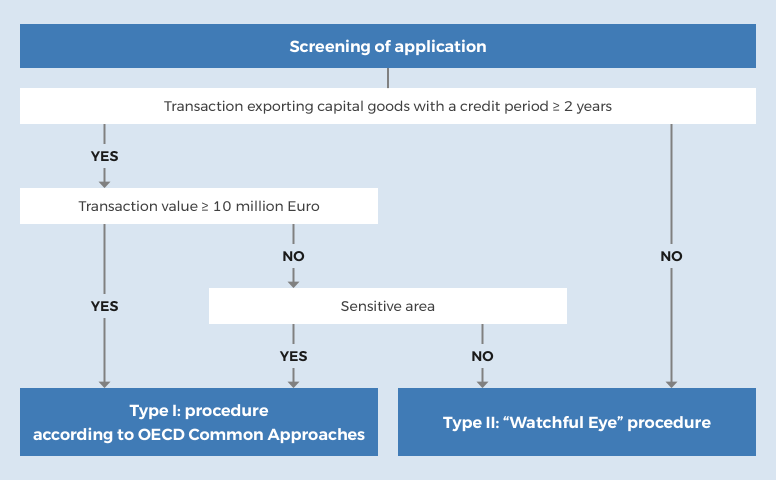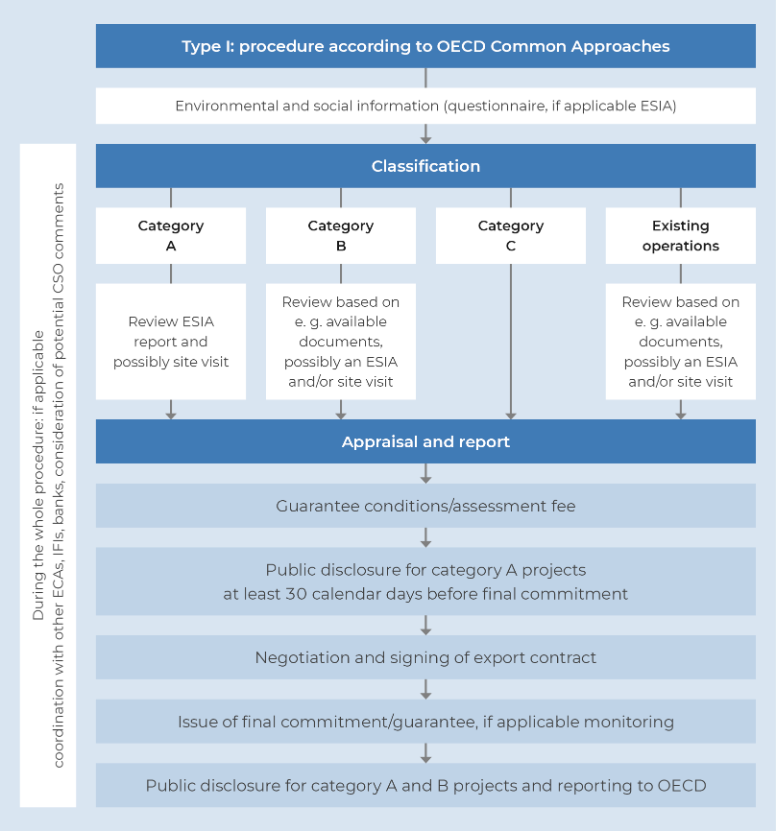Domestic and international regulations require OeKB to ensure projects fulfil environmental and social criteria.
Committed to the OECD “Common Approaches”
The OECD countries have committed themselves to considering environmental and social impacts on officially supported export credits within the scope of the “Common Approaches”. The social impacts include project-related human rights issues, such as the protection of cultural assets, involuntary resettlement, effects on indigenous peoples, as well as forced labour and child labour.
The “Common Approaches” apply to export transactions with an officially supported export guarantee with a repayment term of two years or longer.
Common goals
The goal of the application of the “Common Approaches” is to heighten awareness of the environmental and social aspects in the buyer countries. The “Common Approaches” are intended to harmonise the environmental and social assessment procedures of all Export Credit Agencies (ECAs) to avoid distortions of competition. This ensures that ECAs from OECD countries operate under the same competitive conditions (with a level playing field).
OeKB's environmental and social assessment procedure
In addition to the OECD “Common Approaches”, we are also committed to the Sustainability Strategy of the Export Promotion Procedure. Pursuant to the Austrian guidelines, we also consider positive impacts on the environment and society in the overall assessment of the project.
The "Sustainability Strategy of the Export Promotion Procedure" of the Federal Ministry of Finance is based on a "two-pillar approach":
Pillar 1 – Incentivize sustainable projects
The first pillar consists of instruments to incentivize sustainable projects. More favorable financing conditions are offered for projects in the areas of renewable energies, energy efficiency or combating environmental pollution. This is done with existing financing instruments such as Exportinvest Green, Exportinvest Green Energy and other green products.
Pillar 2 – End covering fossil fuel projects
The second pillar provides for the end of covering for projects in the field of fossil fuels coal, oil and natural gas. From January 1, 2025, the assumption of liability for projects in this area will be ended according to a multi-stage exit plan. This affects projects along the entire value chain, from mining and extraction to transport, processing and power generation using thermal power plants.
This two-pillar approach is intended to promote both climate change mitigation efforts and climate change adaptation. The "Sustainability Strategy of the Export Promotion Procedure" can be found on the website of the Federal Ministry of Finance: Export Liability Procedure
Social responsibility
International Framework
In the course of a general OeKB assessment procedure, we also pay attention to the environmentally and socially relevant criteria before approving an application. To this end, we contact the relevant exporters and banks. If necessary, we request detailed external expert reports.
The OeKB environmental and social assessment procedure is a multi-stage procedure which begins with a screening that classifies a project as Type I or Type II.
The Austrian environmental and social assessment procedure

Key information
We have compiled key information on the environmental and social assessment procedure for you.
Type I environmental and social assessment in accordance with the “Common Approaches”
If your project is classified as a Type I, according to the “Common Approaches”, we are required to evaluate environmental and social standards in accordance with a set procedure. The projects are divided into four categories: Category A, Category B, Category C and existing operations. This classification determines how extensive the assessment will be.
Show more
Type II audit: “Watchful Eye” principle
Projects with a repayment term of less than two years and an order value of less than €10 million do not come under the OECD “Common Approaches”. However, if environmental and social consequences are expected, we will evaluate these projects using a Type II assessment in accordance with the “Watchful Eye” principle.
Show More
Depending on the nature of the project, our export services team may ask you to answer questions about the project/location or to submit an environmental and social aspects questionnaire.
Questions about the project/location
Questions about the project/location - General
Questions about the project/location - Hydropower
Questions about the project/location - Railway
Questions about the project/location - Mining
Questions about the project/location - Fossil Fuels
Standardised questionnaire to collect information on the project
Our completion guide will help you to fill out the questionnaires:
Completion guide for questionnaires
If you have any questions, please contact projektanalysen@oekb.at
Environmental and social questionnaire by sector
Questionnaire for the iron and steel sector
Questionnaire for the thermal power plant sector
Questionnaire for the dam and hydropower sector
Questionnaire for the pulp and paper sector
All other sectors
Environmental and social questionnaire
Transparent procedure
In accordance with the “Common Approaches”, we publish information on Category A projects on our website at least 30 days before final commitment. We present Category A and B projects on the OeKB website after final commitment.
You can find information on the OECD regulations regarding export guarantees and more details on the “Common Approaches” on the OECD website under the following links:
